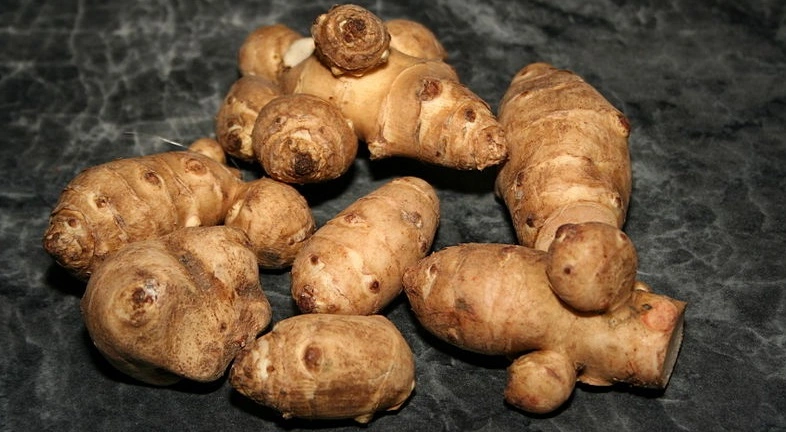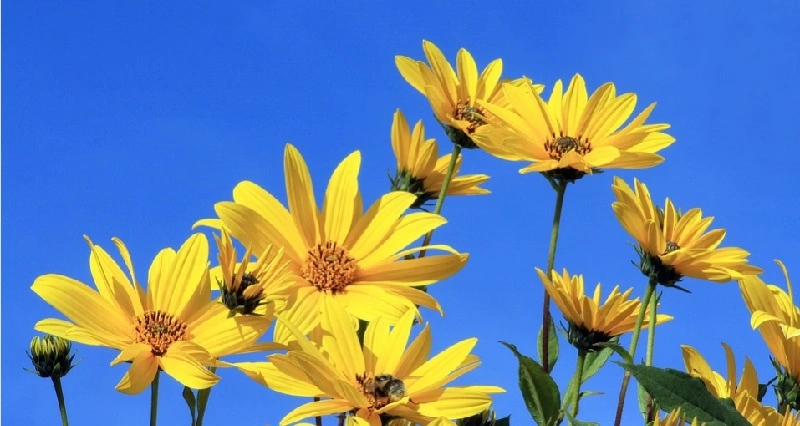Jerusalem artichoke is an absolutely unpretentious plant that can grow in one place for up to 30 years and with proper use will help you maintain health.
Jerusalem artichoke is a plant from the comfrey family and a close relative of the sunflower, originating from North America. It is a perennial plant with straight thin stems and hard rough leaves, up to 3 m in height. Attached to Jerusalem artichoke rhizomes are edible, knotty, oblong tubers of a yellowish, brown, or reddish color, which ripen in autumn and are completely ready for consumption after the first frost. Jerusalem artichoke tubers look a bit like ginger roots. Jerusalem artichoke tubers are delicious and have healing properties. Jerusalem artichoke is very cold-resistant, its tubers winter well in the soil, so in cold regions you can harvest earthen pears in autumn or early spring, and in warmer regions – all winter.
How to plant Jerusalem artichoke
Jerusalem artichoke is undemanding to the soil, but it grows worse on acidified soils and in low-lying areas where water stagnates in the spring. Jerusalem artichoke culture can be used to develop heavy soils. For Jerusalem artichoke, the site is dug up in the fall, and organic and mineral fertilizers are applied to poor soils. Jerusalem artichoke is propagated by tubers, for planting tubers are selected from a small chicken egg. The time of planting Jerusalem artichoke coincides with the planting of potatoes – the end of April – mid-May.
Jerusalem artichoke tubers are planted in a trench. Then carefully fill the trench with earth and make a small ridge over the tubers with a rake. The depth of planting Jerusalem artichoke is 15 cm, the distance between tubers in a row is 45 cm, the distance between rows is 1 meter. The approximate time from planting Jerusalem artichoke to the first sprouts is 2-4 weeks. The time from planting to autumn harvest of Jerusalem artichoke is 40-50 weeks.

Jerusalem artichoke care
Jerusalem artichoke care is technically simple. Jerusalem artichoke is easy to care for. When the stems reach a height of 30 cm, the plants are turned over.
In severe drought, watering is necessary. When the Jerusalem artichoke stems rise to a meter high, a trellis is placed at the beginning and at the end of the bed, and a plastic-wrapped wire is attached to it on both sides of the plants. This must be done because the high stems of Jerusalem artichoke are strongly swayed by the wind and may break. It is very convenient to plant Jerusalem artichoke along the fence. During the period of budding, Jerusalem artichoke is fed with a liquid solution of microfertilizers or mineral fertilizer, and the buds are removed as they form.
In autumn, after the leaves wither, Jerusalem artichoke stems are cut at a height of 30 cm above the soil level. Jerusalem artichokes can be harvested in autumn, in September – November, and in spring, or in April – May of the following year. Plants left on the bed until spring are sprinkled with earth, humus or covered with straw for the winter. In the spring, all Jerusalem artichoke tubers are dug up, selecting the ones needed for planting. If the tubers are not dug up, Jerusalem artichoke will grow and can clog the garden. As a rule, non-varietal Jerusalem artichoke with white skin is grown in gardens.
Its yield is 1-2 kg of tubers from one plant. If you have the opportunity, buy varietal planting material, the yield of varietal Jerusalem artichoke will please you.
Storage of Jerusalem artichoke tubers
Harvested Jerusalem artichoke tubers require high humidity during storage.
Store Jerusalem artichoke in the vegetable compartment of the refrigerator, wrapped in a damp cloth, for no more than a week or two.

